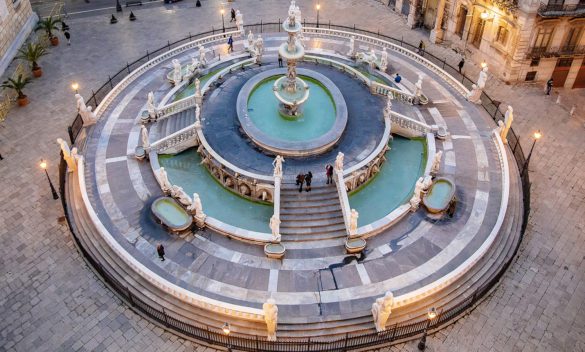Visit Palermo • The Praetorian Fountain

History of the Praetorian Fountain
The Praetorian Fountain, located in the heart of the historic city of Palermo, is an extraordinary work of the Tuscan Renaissance. Built by Francesco Camilliani in Florence in 1554, the fountain is made of white Carrara marble and is one of the main points of interest of the city. Its construction was commissioned for a Florentine villa, but was later bought by Palermo and reassembled in its current location in 1574.
Address: Piazza Pretoria
Description and Symbolism
The fountain consists of several concentric rings divided by a water tank, surmounted by staircases that serve as small bridges and marble parapets. In the middle, a stem composed of three basins placed one on the other, holds a little puttino with a cornucopia, a mythological symbol of food and abundance. The gods of Olympus, allegorical figures of the rivers of Palermo and numerous statues of men, women and pagan gods pour water into the pools. The fountain is surrounded by a wrought iron railing made by Giovanni Battista Basile in 1858.
Legend of the “Piazza della Vergogna”
The fountain is commonly called “Piazza della Vergogna” because of the nakedness of its statues. According to a legend, the name could derive from the complaints of the people of Palermo for the amount spent by the Senate to buy the monument. Another legend tells that the statues were emasculated by the nuns of a nearby convent, mortified for their nakedness. However, looking at the fountain, it can be noted that few statues were actually damaged in this way.
- History of the Praetorian Fountain
- Description and Symbolism
- Legend of the “Piazza della Vergogna”
- conclusions
- Where is Praetorian Fountain located?
- Video
conclusions
The Praetorian Fountain is an artistic masterpiece with a fascinating history and intriguing legends that increase its charm and mystery. Its beauty and historical importance make it an essential stop for those visiting Palermo.
Where is Praetorian Fountain located?
The Praetorian Fountain is located in Piazza Pretoria, in the historic center of Palermo.
The fountain is a monumental work created by the Florentine sculptor Francesco Camilliani in 1554 and 1555. After being built in Florence, it was dismantled and moved to Palermo, where it was reassembled in 1574.
Its exact location is in 38°06′56″N 13°21′43″E
video
ACCOMODATIONS NEAR PALERMO
Explore the best accommodation facilities near Palermo, between Hotels, B&B and Apartments, selected based on thousands of verified reviews.
Last updated on: 10/12/2023 02:18:12
 BUDGET ACCOMODATIONS
BUDGET ACCOMODATIONS HOTEL
HOTEL APARTAMENTS
APARTAMENTS HOTEL FOR FAMILIES
HOTEL FOR FAMILIES